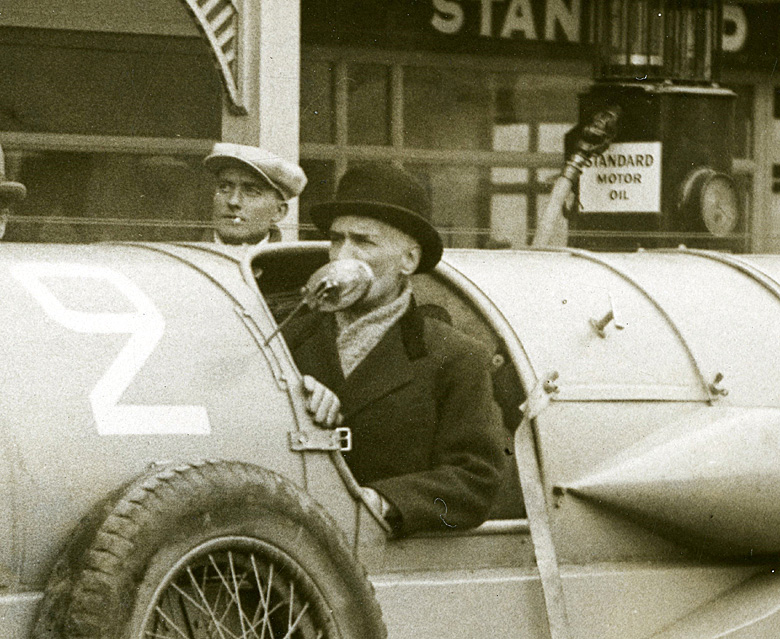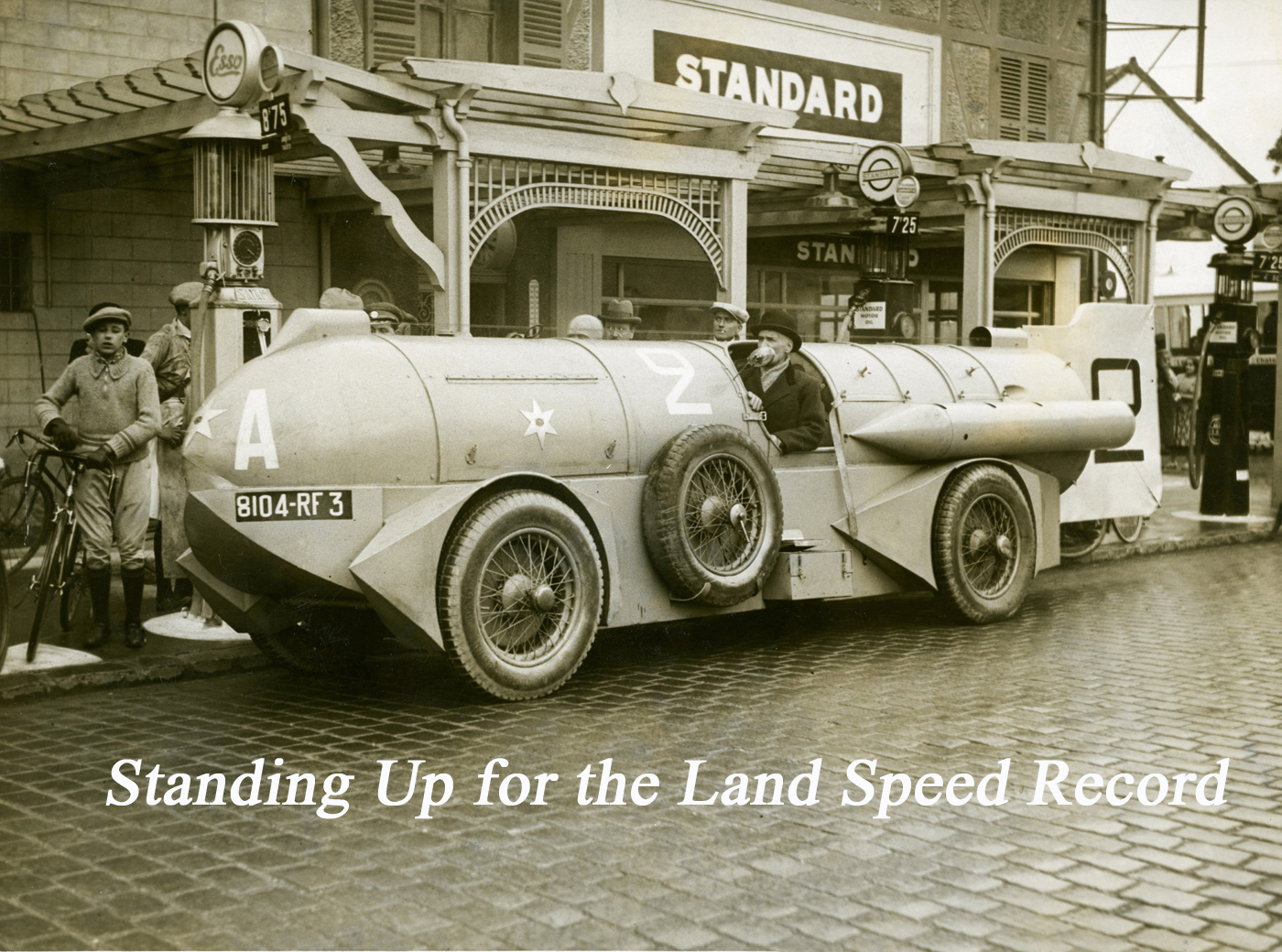Story by Dale LaFollette
Stop the Press! Oh, we can’t but this bit of Youtube just surfaced in reference to the below article and it simply must be seen!!!
I have spent the last twenty-five years collecting, buying and selling period racing photography that interested me. I have known of the car illustrated here and had spent several years looking for a good vintage print when this one became available. My reason for the search was based on the wonderful story surrounding the builder of this car and the car itself.
In 1932 René Stapp, who has been described both as a racing driver and automotive engineer, announced to the world that he had spent the previous two years building a land speed record car in his workshop on the outskirts of Paris. He said the car would be powered by three Jupiter radial engines which he would convert to internal combustion turbines by removing the pistons from them. The engines would make 800 horsepower each and would transmit their power to all four wheels by an electric transmission. He estimated that the car could attain maximum speed of 372 mph (600 kph) and it would do so on the sands of Daytona Beach which was his goal.
If you have digested the above you have already formed an opinion of who René Stapp really was and it may not be all that complimentary. But wait a moment; just consider the car in the photograph. This vehicle was not the product of an idle afternoon as it is easy to see that some serious thought, even if misguided, went into it.
The car was constructed on an older Voisin chassis. The Voisin engine was left in place to be used as a starter motor for the radial engines! And, the Voisin engine powered the car to Paris and on demonstration runs in Paris, so it was probably the only power the car had throughout its career, as there has never been evidence that the radial engines were ever actually installed.
The car as pictured here is on its the way down St Germain Road to Paris, and since it was being driven on the road (by Mr. Stapp) that might be the excuse for the rearview mirror and the spare tire. But it is the first land speed record car I have ever seen with these accessories. Nor have I ever heard any explanation for the stars, letters and numbers on the vehicle.
But I have figured out one other unusual feature.

The buckle is clear enough, but the belt itself can be seen at the opposite side of the cockpit. Apparently Stapp is actually standing in the car, not sitting.
Notice the strap hanging down from the rear of the cockpit. There is a buckle at the front edge of the cockpit so when the strap was buckled in place it reduced the cockpit opening to help keep the driver aboard. This was made necessary by the fact that the driver was to stand in the cockpit much like a railroad engineer while driving. At the time of this photograph the absolute land speed record was held by Malcolm Campbell in his Bluebird at 246.09 mph. I really doubt that standing was an option while attempting to break that record.
Sometime after arriving in Paris and conducting demonstration runs, Mr. Stapp drove his car to the beach at La Baule in Brittany for a practice run. But then if the radial engines had never been installed what was there to practice? Was it some sort of ruse? In any case while on the sand at La Baule the car caught on fire and burned to the ground while René jumped clear, unhurt, we assume the car a total loss.
From there Mr. Stapp shuffled off to obscurity, his land speed record hopes gone. I think you can see that he had no real chance from the outset to gain the record, so was it all a con or was he completely naive to the reality? Or maybe his goal was just to have his name remembered in the history books and magazine articles for the next 87 years. If so, well played Mr. Stapp!
Sources:
LAND SPEED RECORD by Cyril Posthumus
MOTOR RACING AND RECORD BREAKING by G.E.T. Eyston (photo and photo description only)
Also thanks to David Tremayne, who did an update to the Posthumus book and is a world authority on LS

Nice article and nice photo, a well-known one.
I fully agree with the conclusion of the article.
I can add something taken from 1932 Daytona Beach dailies (unfortunately, no date was written on the clippings).
The accident at La Baule is reported as having destroyed the car and caused a fractured knee to Mr Andre Stapp when jumping out of the cockpit. The riding mechaninc is said to have been badly bruised.
Stapp is defined as: “a noted French engineer” and said to have another car ready for the sands of Daytona Beach.
He was officialy invited by Mayor Armstrong to show up in the 1933 LSR trials in Daytona Beach.
A picture of the car from the rear shows a cone shaped rear end, same diameter of the body, sporting two circular rows of 12 and 6 exhausts. The left gun-like side attachment is closed by the license plate at the end.
The tail fin looks as being covered in fabric.
The car is said to have been named “Mademoiselle France” (French girl).
Thanks Aldo for the additional information. As to Daytona, Wikipedia has used this same photograph to illustrate the car and Mr. Stapp and they say it was taken in Daytona. So much for trusting the internet! I am sure they (whoever “they” are) were confused by the Standard service station sign. The back of my photograph has a news release on it from a well known agency stating that it was taken on St. Germain Road on the way to Paris. I even found a Florida website that uses the photo saying that it was taken at Daytona Beach so they got caught trusting the web too!
Great stuff Dale and Aldo.
Yes, this amazing device even rated a color rendering in the Cyril Posthumus book.
I immediately went to my patent search engine but could find no patents that would provide a clue to the internals of this vehicle.
Hi Karl, Yes, when I discovered the foot plate on the tool box in the photo I then went to the book to see if it was in the painting, it is! The vehicle would look most at home in a Russian military parade.
While most will agree that Stapp had no chance at any sort of a record even with his magical turbine engines but you can understand his national pride being wounded by the land speed battle at Daytona in the 1920s and 30s being fought only by the English and the Americans.
could the license plate be looked-up in old French records? and jay Leno should build a replica